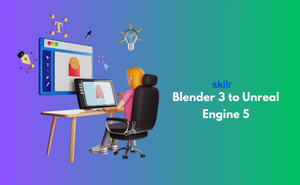👇 CELEBRATE CLOUD SECURITY DAY 👇
00
HOURS
00
MINUTES
00
SECONDS

Blender 3 to Unreal Engine 5
Industry-endorsed certificates to strengthen your career profile.
Start learning immediately with digital materials, no delays.
Practice until you’re fully confident, at no additional charge.
Study anytime, anywhere, on laptop, tablet, or smartphone.
Courses and practice exams developed by qualified professionals.
Support available round the clock whenever you need help.
Easy-to-follow content with practice exams and assessments.
Join a global community of professionals advancing their skills.
The long-term potential is immense, as industries increasingly adopt real-time technologies for immersive experiences. Unreal Engine 5’s capabilities in rendering and interactivity, combined with Blender’s flexibility, make them indispensable tools for future projects in gaming, films, virtual reality, and beyond. As the demand for skilled professionals grows, investing time in mastering these tools is a valuable career decision.
Absolutely! These skills are widely applicable in non-gaming fields like architectural visualization, product design, education, and virtual reality. For instance, Unreal Engine 5 is often used for creating walkthroughs of buildings, interactive educational content, and virtual simulations for training purposes.
Staying current requires actively engaging with online communities, tutorials, and forums. Platforms like Unreal Engine’s official blog and Blender’s community forums offer valuable updates. Enrolling in online courses and following industry leaders on platforms like YouTube or LinkedIn can also help you stay informed about new features and trends.
The market demands professionals who can create realistic 3D assets, optimize them for real-time engines, and develop interactive environments. Skills in modular design, PBR (Physically Based Rendering) material creation, and lighting setups are particularly valuable as industries shift towards virtual production and immersive experiences.
The popularity of Blender stems from its cost-effectiveness and robust features for modeling, animation, and rendering, while Unreal Engine 5 offers unparalleled real-time rendering capabilities. Together, they allow for efficient workflows in creating high-quality visuals and interactive content, aligning with current industry demands for immersive and cost-efficient solutions.
Key roles include 3D modeler, game artist, technical artist, level designer, and virtual production specialist. These roles require a deep understanding of asset creation, modular workflows, and real-time rendering pipelines. Additionally, these skills are valuable for creating visual effects and interactive experiences in media and entertainment.
Mastering these tools opens doors to various industries, including gaming, animation, film production, and virtual reality. Many companies seek professionals skilled in asset creation, modular design, and real-time rendering for immersive projects. These skills are especially in demand for roles such as 3D artists, game developers, and virtual production specialists.
Yes, there is a high demand for freelance professionals with Blender and Unreal Engine 5 expertise. Freelancers can offer services in 3D modeling, animation, asset optimization, and real-time rendering. Many indie game developers and small studios also hire freelancers for short-term projects or to enhance specific elements of their designs.
Industries like gaming, architectural visualization, film production, and virtual reality benefit significantly from expertise in Blender and Unreal Engine 5. Game studios use these tools for asset creation and level design, while filmmakers rely on real-time rendering for virtual production. Additionally, architects and designers use Unreal Engine for realistic visualizations of projects.
To effectively transition from Blender 3 to Unreal Engine 5, you need strong proficiency in 3D modeling, texturing, and animation using Blender. Additionally, familiarity with Unreal Engine’s features, such as asset importing, material creation, lighting setups, and real-time rendering with Nanite and Lumen, is crucial. Understanding workflows for optimizing assets for real-time performance is also key to meeting industry standards.